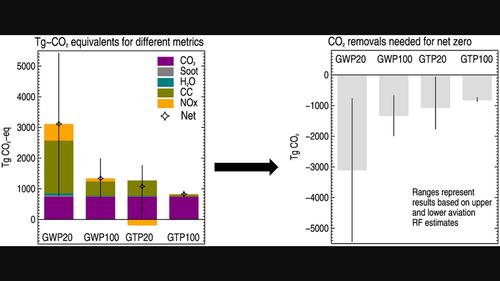当前位置:
X-MOL 学术
›
WIREs Clim. Chang.
›
论文详情
Our official English website, www.x-mol.net, welcomes your feedback! (Note: you will need to create a separate account there.)
A “greenhouse gas balance” for aviation in line with the Paris Agreement
WIREs Climate Change ( IF 9.2 ) Pub Date : 2023-06-12 , DOI: 10.1002/wcc.839 Jan Fuglestvedt 1 , Marianne T. Lund 1 , Steffen Kallbekken 1 , Bjørn Hallvard Samset 1 , David S. Lee 2
WIREs Climate Change ( IF 9.2 ) Pub Date : 2023-06-12 , DOI: 10.1002/wcc.839 Jan Fuglestvedt 1 , Marianne T. Lund 1 , Steffen Kallbekken 1 , Bjørn Hallvard Samset 1 , David S. Lee 2
Affiliation

|
The effects of aviation on climate pose unique policy challenges. A large fraction of the CO2 emissions (65%) is international and not (explicitly) included in the Paris Agreement. The interpretation of Article 4.1 on achieving a “balance between anthropogenic emissions by sources and removals by sinks of greenhouse gases” is ambiguous in the context of aviation because of the substantial non-CO2 effects associated with the sector. For the achievement of the temperature goal in Article 2, both CO2 and non-CO2 effects are important. The non-CO2 effects contribute 66% of the sectoral total climate effect (in terms of Effective Radiative Forcing; ERF) at present, with significant uncertainties. The largest of these non-CO2 effects, contrail-cirrus and the net-effect of NOx, are not caused by direct greenhouse gas emissions, representing another ambiguity as to whether they should be included in the balance concept. We discuss the role of aviation in the context of the Paris Agreement, and present illustrative calculations of a hypothetical aviation “greenhouse gas balance.” Several questions are addressed: Which components should be included? If an aggregate of components is adopted for the “balance,” which metric should be used? How can the large differences in timescales as well as the large intrinsic underlying ERF uncertainties be handled? We demonstrate that these choices result in very different requirements for CO2-removal from the atmosphere and different temperature outcomes over time. The article provides policymakers with an overview of issues and choices that are important regarding which approach is most appropriate for defining and achieving a greenhouse gas balance for aviation in the context of the Paris Agreement.
中文翻译:

符合《巴黎协定》的航空业“温室气体平衡”
航空对气候的影响带来了独特的政策挑战。CO 2排放量的很大一部分(65%) 是国际排放量,并未(明确)包含在《巴黎协定》中。在航空领域,由于与该行业相关的大量非CO 2影响,第4.1 条关于实现“人为温室气体源排放与汇清除之间的平衡”的解释是含糊不清的。为了实现第2条中的温度目标,CO 2和非CO 2效应都很重要。非CO 2目前,这些效应占部门总气候效应(以有效辐射强迫;ERF 计)的 66%,具有很大的不确定性。其中最大的非 CO 2效应、轨迹卷云和 NO x的净效应,不是由直接温室气体排放引起的,这代表着是否应将其纳入平衡概念的另一个模糊性。我们讨论了航空在《巴黎协定》背景下的作用,并对假设的航空“温室气体平衡”进行了说明性计算。解决了几个问题:应该包括哪些组件?如果采用多个组成部分的集合来衡量“平衡”,那么应该使用哪个指标?如何处理时间尺度上的巨大差异以及 ERF 内在的巨大不确定性?我们证明这些选择会导致对 CO 2的要求截然不同-随着时间的推移,从大气中去除并产生不同的温度结果。本文为政策制定者概述了在《巴黎协定》背景下哪种方法最适合定义和实现航空温室气体平衡的重要问题和选择。
更新日期:2023-06-12
中文翻译:

符合《巴黎协定》的航空业“温室气体平衡”
航空对气候的影响带来了独特的政策挑战。CO 2排放量的很大一部分(65%) 是国际排放量,并未(明确)包含在《巴黎协定》中。在航空领域,由于与该行业相关的大量非CO 2影响,第4.1 条关于实现“人为温室气体源排放与汇清除之间的平衡”的解释是含糊不清的。为了实现第2条中的温度目标,CO 2和非CO 2效应都很重要。非CO 2目前,这些效应占部门总气候效应(以有效辐射强迫;ERF 计)的 66%,具有很大的不确定性。其中最大的非 CO 2效应、轨迹卷云和 NO x的净效应,不是由直接温室气体排放引起的,这代表着是否应将其纳入平衡概念的另一个模糊性。我们讨论了航空在《巴黎协定》背景下的作用,并对假设的航空“温室气体平衡”进行了说明性计算。解决了几个问题:应该包括哪些组件?如果采用多个组成部分的集合来衡量“平衡”,那么应该使用哪个指标?如何处理时间尺度上的巨大差异以及 ERF 内在的巨大不确定性?我们证明这些选择会导致对 CO 2的要求截然不同-随着时间的推移,从大气中去除并产生不同的温度结果。本文为政策制定者概述了在《巴黎协定》背景下哪种方法最适合定义和实现航空温室气体平衡的重要问题和选择。



























 京公网安备 11010802027423号
京公网安备 11010802027423号